#urban gardening in los angeles
Text
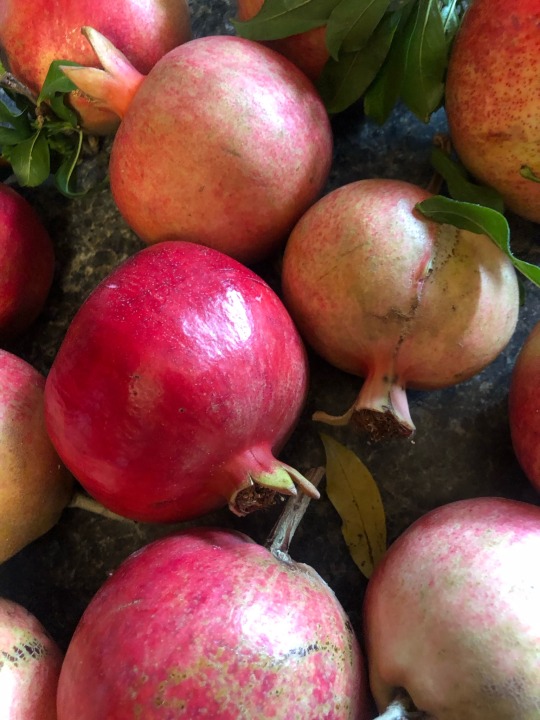
Todays pomegranate harvest from my backyard.
79 notes
·
View notes
Text
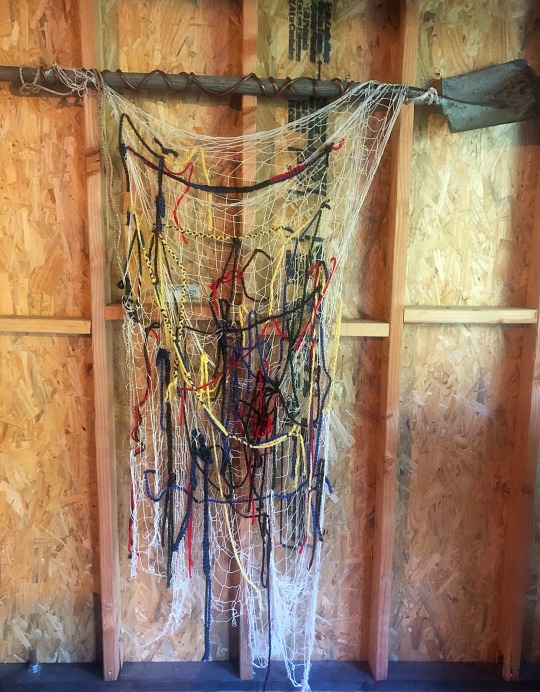


Community artwork led by Zoe Blaq.
1 note
·
View note
Text
Have you ever looked at roses and wondered if they were tasty? (Or maybe you went to a restaurant with something like rose milk tea with rose jelly that you got & liked).
Well, here is a guide to eating roses.
(Please note that people tend to put all kinds of nasty chemicals on roses sold both commercially & that you find growing at a neighbor's house, so please make sure they are unsprayed/untreated/organic before consuming them and always ask permission if they are growing on someone else's land).
First, go early in the morning (as that lovely rose scent will disappear as the day heats up) & pick some just opening flowers. Then wash them to remove dirt and bugs.
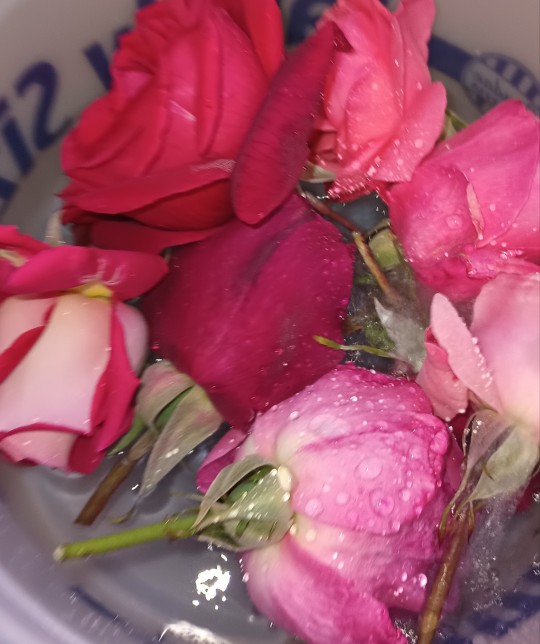
These are some common domestic roses (Mr. Lincoln, Queen Elizabeth, etc), but if you are buying roses to eat, supposedly Damascus roses are the best. Next, you will gently remove the petals from the stem (a slight twist & pull is usually sufficient). Now you have to choose preparing fresh (rose jam, rose jelly, rose syrup, rose oil, rose water, etc) or drying them for later.
In this case, I dried them.

As you can see, once I had just over 2 quarts/2 liters, I proceeded to the next step. Grinding them to a fine powder in the blender.

As you can see, grinding the petals dramatically reduces the overall volume. For long term storage of the powder, I sift it (through a sieve) and dry again before storing it in glass jars.
This powder is really nice to have on hand. One spoonful into a cup of hot water or coffee makes a nice drink. Or you can add it to baked goods for rose flavor & color.
In this case, I am going to make waffles. I started with a commercial pancake mix, added ingredients suggested on the box and a good amount (no more than 1/10 the volume of mix/flour) of rose powder. After making the waffles, they looked like this:

I also had some rose syrup using a recipe from a really interesting cookbook about Lebanese pantry staples (which can be made from things that grow well in Mediterranean climates like roses).

The rose syrup was interesting to make as the pigments in the rose petals leach into boiling water, leaving clear, transparent, and slightly chewy petals behind. The book has lots of recipes for fresh rose petals. I water bath canned them for 15 minutes so I can store it long term. It was a two day process to make.
Then I combined the rose waffles with rose syrup to moisten them.

Finally, I used hot water to clean the blender & make my first batch of rose tea. I think the purple color is from my Mr. Lincoln rose.

So there is an entire meal from roses. (If you want a clear tea, use dried whole rose petals & strain them out before drinking).
#rose#homegrown#homemade#waffles#herbal tea#unique flavors#edible rose#rose syrup#urban farming#urban garden los angeles#plantblr
10 notes
·
View notes
Text



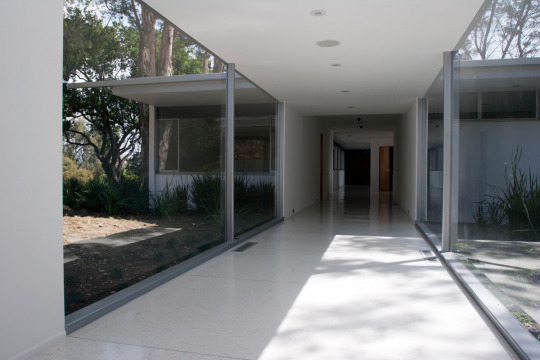
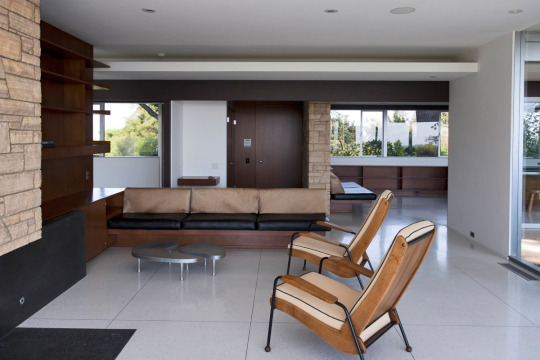
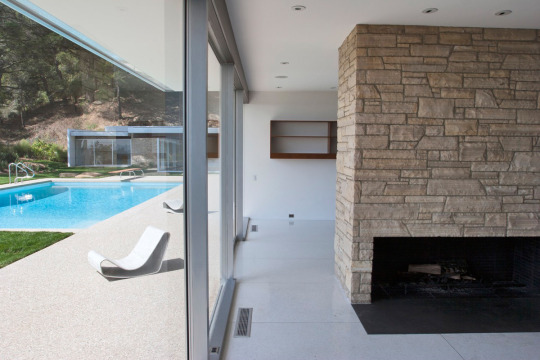




Singleton Residence | Richard Neutra
Bel Air, Los Angeles, CA | United States | 1959
The Fifties and early Sixties formed a period of great creativity and productivity for Richard Neutra. The majority of his residential commissions of this time were in California, whose temperate climate allowed him to perfect buildings that were closely connected to the landscape. Neutra tailored each house to his clients’ needs, aiming to create homes that were not only ergonomic, practical and engaging but could also improve well-being and make a better way of living. The Singleton House in Bel Air sits on an enticing site by Mulholland Drive. From this elevated positions, the views are extraordinary - taking in the city in one direction but also offering an open vista towards the San Gabriel Mountains. The home was commissioned by engineer-turned-industrialist and rancher Henry Singleton and his family; later, they also commissioned a house by Wallace Neff. Neutra’s single-level house capitalizes on the views - particulary, those of the mountains. The processional approach was engaging in itself, with a long series of steps leading up to the front entrance sitting under a pergola. Water pools around the main living spaces add another dimension - especially when the sliding glass walls retract and reflect the sky. Later, the house was renovated and updated by the late Vidal Sassoon and his wife Ronnie.
Images: © Studio Tim Campbell. All rights reserved.
Words: © thegreatdaydreamer
#architecture#modern architecture#singleton residence#bungalow#pavilion#house design#design#interior design#lifestyle#midcenturyhome#midcenturymodernhome#los angeles#urban architecture#swimming pool#garden#bel air#richard neutra#luxury houses#luxuryhomes
56 notes
·
View notes
Text
As relentless rains pounded LA, the city’s “sponge” infrastructure helped gather 8.6 billion gallons of water—enough to sustain over 100,000 households for a year.
Earlier this month, the future fell on Los Angeles. A long band of moisture in the sky, known as an atmospheric river, dumped 9 inches of rain on the city over three days—over half of what the city typically gets in a year. It’s the kind of extreme rainfall that’ll get ever more extreme as the planet warms.
The city’s water managers, though, were ready and waiting. Like other urban areas around the world, in recent years LA has been transforming into a “sponge city,” replacing impermeable surfaces, like concrete, with permeable ones, like dirt and plants. It has also built out “spreading grounds,” where water accumulates and soaks into the earth.
With traditional dams and all that newfangled spongy infrastructure, between February 4 and 7 the metropolis captured 8.6 billion gallons of stormwater, enough to provide water to 106,000 households for a year. For the rainy season in total, LA has accumulated 14.7 billion gallons.
Long reliant on snowmelt and river water piped in from afar, LA is on a quest to produce as much water as it can locally. “There's going to be a lot more rain and a lot less snow, which is going to alter the way we capture snowmelt and the aqueduct water,” says Art Castro, manager of watershed management at the Los Angeles Department of Water and Power. “Dams and spreading grounds are the workhorses of local stormwater capture for either flood protection or water supply.”
Centuries of urban-planning dogma dictates using gutters, sewers, and other infrastructure to funnel rainwater out of a metropolis as quickly as possible to prevent flooding. Given the increasingly catastrophic urban flooding seen around the world, though, that clearly isn’t working anymore, so now planners are finding clever ways to capture stormwater, treating it as an asset instead of a liability. “The problem of urban hydrology is caused by a thousand small cuts,” says Michael Kiparsky, director of the Wheeler Water Institute at UC Berkeley. “No one driveway or roof in and of itself causes massive alteration of the hydrologic cycle. But combine millions of them in one area and it does. Maybe we can solve that problem with a thousand Band-Aids.”
Or in this case, sponges. The trick to making a city more absorbent is to add more gardens and other green spaces that allow water to percolate into underlying aquifers—porous subterranean materials that can hold water—which a city can then draw from in times of need. Engineers are also greening up medians and roadside areas to soak up the water that’d normally rush off streets, into sewers, and eventually out to sea...
To exploit all that free water falling from the sky, the LADWP has carved out big patches of brown in the concrete jungle. Stormwater is piped into these spreading grounds and accumulates in dirt basins. That allows it to slowly soak into the underlying aquifer, which acts as a sort of natural underground tank that can hold 28 billion gallons of water.
During a storm, the city is also gathering water in dams, some of which it diverts into the spreading grounds. “After the storm comes by, and it's a bright sunny day, you’ll still see water being released into a channel and diverted into the spreading grounds,” says Castro. That way, water moves from a reservoir where it’s exposed to sunlight and evaporation, into an aquifer where it’s banked safely underground.
On a smaller scale, LADWP has been experimenting with turning parks into mini spreading grounds, diverting stormwater there to soak into subterranean cisterns or chambers. It’s also deploying green spaces along roadways, which have the additional benefit of mitigating flooding in a neighborhood: The less concrete and the more dirt and plants, the more the built environment can soak up stormwater like the actual environment naturally does.
As an added benefit, deploying more of these green spaces, along with urban gardens, improves the mental health of residents. Plants here also “sweat,” cooling the area and beating back the urban heat island effect—the tendency for concrete to absorb solar energy and slowly release it at night. By reducing summer temperatures, you improve the physical health of residents. “The more trees, the more shade, the less heat island effect,” says Castro. “Sometimes when it’s 90 degrees in the middle of summer, it could get up to 110 underneath a bus stop.”
LA’s far from alone in going spongy. Pittsburgh is also deploying more rain gardens, and where they absolutely must have a hard surface—sidewalks, parking lots, etc.—they’re using special concrete bricks that allow water to seep through. And a growing number of municipalities are scrutinizing properties and charging owners fees if they have excessive impermeable surfaces like pavement, thus incentivizing the switch to permeable surfaces like plots of native plants or urban gardens for producing more food locally.
So the old way of stormwater management isn’t just increasingly dangerous and ineffective as the planet warms and storms get more intense—it stands in the way of a more beautiful, less sweltering, more sustainable urban landscape. LA, of all places, is showing the world there’s a better way.
-via Wired, February 19, 2024
#california#los angeles#water#rainfall#extreme weather#rain#atmospheric science#meteorology#infrastructure#green infrastructure#climate change#climate action#climate resilient#climate emergency#urban#urban landscape#flooding#flood warning#natural disasters#environmental news#climate news#good news#hope#solarpunk#hopepunk#ecopunk#sustainability#urban planning#city planning#urbanism
13K notes
·
View notes
Photo
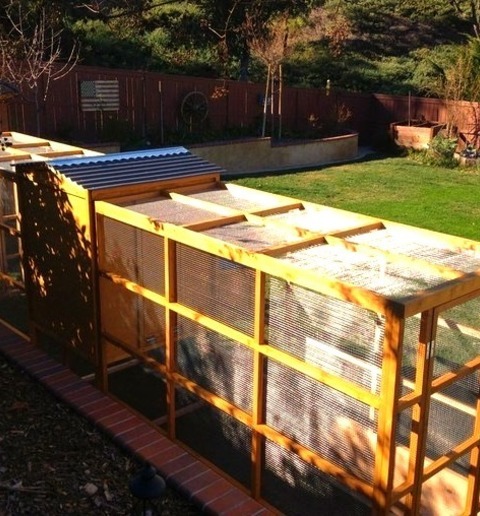
Transitional Landscape in Orange County
Ideas for a sizable, transitional backyard landscaping project.
0 notes
Text
bucktommy earth day fic
getting this in right under the wire.
pretty as a vine
[read on ao3]
“Did you know that Los Angeles has one of the most diverse urban forests in the world?” Evan asked, about five milliseconds after Tommy managed to open his eyes to the early morning sunlight.
Evan was already sitting against the headboard.
“I did not know that,” Tommy said, sleep-rough as he wiped a hand over his face and blinked sleep out of his eyes. Evan was bright-eyed and animated, though there was still a pillow crease on his face and he had a serious case of curly bed-head. Instead of hauling him back down onto the mattress and cuddling him back to sleep, he pushed himself into a sitting position and yawned so wide his jaw cracked.
“Chris sent me an article about urban tree planting his class read to get ready for Earth Day,” he said.
“Oh yeah?”
“Yeah, apparently there’s 95 species of tree native to Los Angeles, but thousands more that are non-native,” he said, putting his phone down, obviously reciting the stats from memory. He never could quite predict what scenario was going to bring forth a bunch of random facts from Evan, but he enjoyed it every time.
Also, he learned a lot.
“What else did you find out?” he asked, peppering the question with a closemouthed kiss against Evan’s mouth, just to see the way his cheeks flushed.
Apparently the research hole he’d gone down was too much to fluster him for long, because he barrelled ahead after a brief pause for a sweet little smile. “Did you know there’s three times as many trees planted in rich neighborhoods here in LA than in poor neighborhoods?” he said, a tiny furrow appearing between his brow. “That’s so unfair - do you know how many benefits trees have? They reduce the temperatures in heat deserts and improve air quality - “
Tommy listened as he continued, gesticulating wildly with his hands as he rattled off facts, and couldn’t help the fond smile that crossed his mouth. He hadn’t been lying, Evan was adorable but - it was also some pretty interesting stuff. Listening to one of Buck’s trivia binges inevitably led him down a rabbit hole of his own, though he was far less prone to sharing it than Buck.
He did on occasion attempt to drop them on Eddie - though that usually got him an eye roll and a teasing comment about how much time he was spending with Buck.
“I think we should do something for Earth Day,” Evan said, after going through an exhaustive list of all the ways planting trees in urban areas helped both the environment and citizens.
“You want to plant a tree?” Tommy asked, brow raised, by now leaning against the headboard, close enough that their shoulders pressed together (or more like bumped every few moments with all the gesturing Evan did).
“No - well, yeah - but it’s kind of short notice for that now,” he said. “I did look into some programs planting trees around the city that accept volunteers but there’s orientations and stuff - I was thinking of running it by Cap, seeing if we can make it a station wide thing, or maybe department wide…”
“Okay,” Tommy said, quiet, even, waiting for Evan to circle back around to what he actually wanted to do now.
“I was thinking I could plant something on my balcony. Not a tree, obviously, maybe some flowers for the bees or something?”
“That sounds doable,” Tommy said with a nod. “Is this something you’d like help with?” he asked.
“I - yeah, I mean if you’re offering,” he said. “I was thinking we could go to the home improvement store and get a little flower box and soil and stuff,” he said.
“Alright,” Tommy said, giving Evan’s thigh a little squeeze as he started to slide out of bed. “Get dressed, I’ll get the coffee going and we’ll head out,” he said.
Three hours later, they’d arrived back to the loft with a huge flower box, two bags of potting soil, two sets of gardening gloves, three different species of bee friendly flowers and a succulent Evan had fallen in love with and refused to leave behind.
Hauling it all up to Evan’s floor, even with the elevator, had been a trek, both of them a little sweaty by the time they carried it all across the threshold.
“There’s an information pamphlet in here somewhere,” Evan said, setting his flowerbox (a gorgeous piece in redwood that had cost a pretty penny but would hold up against rot and decay for as long as Evan wanted it on his balcony) on the kitchen island and rooted around inside where he’d put his part of the haul. Tommy put the large box filled with flowers (and the succulent) on the other side of the island.
“Okay, we’ve got some Great Blanket Flowers, otherwise known as Gaillardia aristata,” he said, pulling out a container with a few orange and yellow flowers, setting them beside the flower boxes on the island. “Then -” he squinted at the paper, “Million Bells, otherwise known as Calibrachoa,” a yellow flower with orange on the inside, “and a Sweet Potato vine, otherwise known as Ipomoea batatas,” he said.
“I was there when we bought them,” Tommy said, amused - it’d taken Evan a full forty-five minutes to narrow down the type of flowers he wanted to get, hemming and hawing about what would have the most benefit for bees, which would last the longest, be the most maintenance free - in the end Tommy’d had to wrangle one of the garden center employees over to give some professional advice before Evan well and truly lost himself in a Reddit spiral.
Evan laughed. “Just refreshing your memory,” he said. “Let’s get the flower box out there and then we can add the soil and start planting!” he said, clapping his hands together.
“Yes, sir,” Tommy said dryly, giving a little salute, the corner of his mouth quirking before he hefted up one of the flower boxes to take outside.
It took a bit of work to get them set up against the edge of the balcony, using some of the brackets that came with it (most of the time had been spent trying to find the drill that Evan had said he’d borrowed from Eddie - they’d found it in the hall closet under a pile of sheets).
“How’s that?” Tommy asked, knees clicking as he straightened up, peering down at the flower boxes that now took up most of the length of the balcony railing.
“Perfect,” Evan said, pressing a kiss to his cheek on his way past to grab the bags of soil. He was so much freer with his affection - Tommy knew it’d taken him some time to get used to it, but he always felt a little spark of warmth with every absent brush of his hand or chaste little kiss, just because - Evan had held his hand on the walk from the parking lot to the home improvement store and he’d had to bite the inside of his cheek to tamp down the smile.
Instead of helping, he watched Evan bring the two bags of soil out, arm muscles bulging, though he didn’t look as if he were exerting himself in the least.
“Both bags should be enough,” Evan said, leaving one to heft the other onto his shoulder and carry it toward the closest box. Tommy grabbed the other and did the same, and it only took a few moments to have it filled to an acceptable (to Evan and presumably the flowers) depth.
After procuring some beers, grabbing the flowers, and then going back inside to grab the two pairs of gloves, they were ready to start planting the flowers. Evan stood back, eyeing the box like a sculptor about to start chisling some marble. Tommy watched, amused and annoyingly fond, as he paced the length of the box, looked back to the box of flowers, and then back again.
“Let’s start with the Great Blanket Flowers,” he finally said after a long moment, giving a decisive nod. Tommy grabbed the flowers from the box - they’d gotten three large ones in separate pots, and set them on the ground next to where Evan had knelt down, gloves already on.
Tommy donned his, kneeling down, ignoring the cracking of his knees, and let Evan take the lead.
“I think they’d look best here at the front,” he said. Tommy nodded - he didn’t have a particular eye for flower arrangements, but he trusted Evan’s judgment. Also, he honestly didn’t think the bees would care one way or the other.
They worked in companionable silence to gently uproot the flowers from their pots, careful not to snag any of the roots. Evan dug some holes with his gloved hand deep enough to easily cover the roots, the soil easily moved. Tommy placed one of the bunches into a hole, patting the soil down around it and let Evan do the other two, reaching for his beer as he watched the careful way Evan handled the plants, even with the unwieldy gloves on.
There was a look of concentration on his face, and Tommy kind of wanted to kiss away that little furrow between his brow. He took a pull of beer instead, setting the bottle down as Evan patted down the last bit of soil.
“There. I think those look good there.” Tommy hummed in agreement. “The sweet potato vines should probably go along the back so they can drape down off the balcony when they grow, and we can fill in the Million Bells in around them?” he said, as if Tommy might have another idea about possible flower arrangements.
He didn’t.
Tommy helped, but mostly just sat back on his heels and watched as Evan arranged the flowers to his liking, his tongue occasionally peeking out between his teeth as he held the flowers in different spots before committing to their final resting place.
When the last flower had been put in place, Evan eased himself back onto his heels, close enough that Tommy could feel the heat of his body, sunwarm and shining faintly with perspiration.
“Looks good,” Tommy said approvingly, though his gaze wasn’t stuck on the flowers. Evan’s was though, a smile lighting up when a bee buzzed by and headed straight for the Blanket Flowers. He watched it for a while, and Tommy watched him watching it, before Evan seemed to tense a little, glancing over at him.
“Hey,” he said, sounding oddly insecure. “Thanks for doing this with me,” he said, eyes bright, as if he imagined Tommy would have agreed to come if he hadn’t wanted to. Tommy didn’t do things he didn’t want to do. He hoped in time he could get Evan to believe that.
“Of course,” Tommy said, leaning forward to kiss him, soft and sweet, forgetting his hand was still gloved as he brought it up to rest against his chin. Evan kissed him back, and when he pulled back he had a smudge of dirt on his jaw.
Tommy grinned, taking his glove off so that he could wipe the smudge away with his thumb.
“There’s nowhere I’d rather be.”
20 notes
·
View notes
Text

A rendering of a rooftop terrace installed by the Parisian startup Roofscapes.
Paris When It Sizzles: The City of Light Aims to Get Smart on Heat
With its zinc roofs and minimal tree cover, Paris was not built to handle the new era of extreme heat. Now, like other cities worldwide, it is looking at ways to adapt to rising temperatures — planting rooftop terraces, rethinking its pavements, and greening its boulevards.
In many cities, this urban remodeling project is already underway. In New York City, workers and volunteers have planted over a million trees to add shade and clean the air. In Seville, Spain, city planners are using the technology of ancient underground waterways to provide cooling for the city without depending on air‑conditioning. In Freetown, Sierra Leone, officials are creating urban gardens, improving access to clean water, and erecting plexiglass awnings over outdoor markets. In Los Angeles, public works crews are painting streets white to increase reflectivity. In India, they are experimenting with green roofs, which absorb heat and create space to grow food.
But perhaps nowhere in the world do the challenges, as well as the opportunities, loom larger than in Paris, where nearly 80 percent of the buildings have zinc roofs — an affordable, corrosion-resistant and virtually inflammable innovation of the 19th century. But those roofs are, in the 21st century, deadly — heating up to 194 degrees F on a summer day. And because top‑floor garrets were not insulated, that heat is transferred directly into the rooms below.
74 notes
·
View notes
Note
top ten first watches of 2023?
I assume you mean films, right? Anyway, top 10 in no particular order.

Crash was a long time coming, but it took a podcast I used to listen to weekly to finally get to this Cronenberg classic. Bodily modifications? Violent eroticism? Body as a machine? Death & eroticism? It has it all and much more.
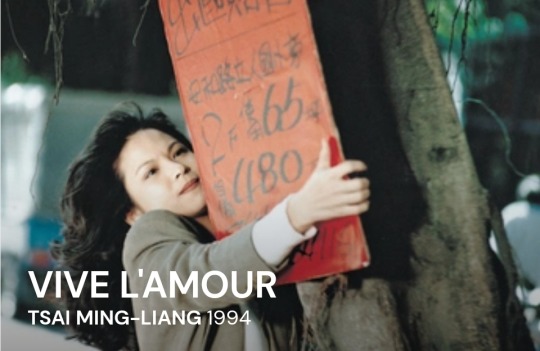
For those of you in your 20s and 30s (or even older) who feel alienated in the urban landscape, surrounded by crowds whilst feeling lonely and yearning for any type of human connection, this film is for you.
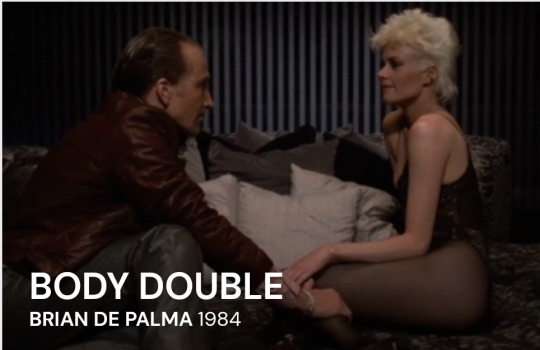
It's no secret that Brian de Palma wanted to be Hitchcock since he was a baby (I assume, but it sure does look so). You can see it in so many movies of his and Body Double is a perfect example. It even has the misogyny down to a T. But it's also really good and I'm a fan of voyeurism in cinema (from a critical position mostly). This is like Rear Window and Vertigo mashed together, but with 80s hair.

Now this was probably the highlight for me this year. Editor by day, sex worker by night, Kathleen Turner is a force in this film, alongside Anthony Perkins, the perverted priest. But if that is not enough to do the trick, the cinematography and that anal sex scene might do the trick 😉

Who knew Joan Crawford had such a big issue with wire hangers? Not me, but I sure found out in that crazy scene that has one of the most memorable meltdowns in cinema. Every shot of Faye Dunaway screams "I want that Oscar, god damn it!"
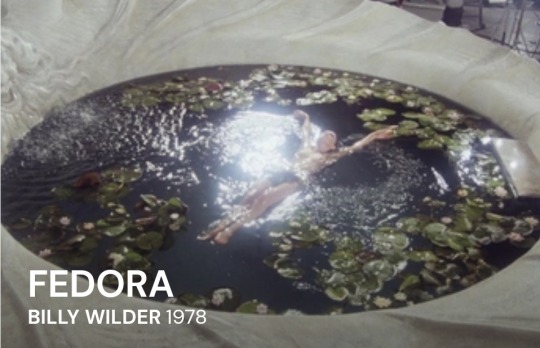
Fedora is the late 70s version of Sunset Boulevard and it has the same director. Not as good as that classic, but my god, the clothes! I'd watch it again just for the clothes, particularly that white suit Fedora is wearing in the garden of her villa when she receives that honorary Oscar.

I don't think there's any Paul Schrader film that I didn't like. It wouldn't make sense to call him underrated, but he's better than others from that 1970s gang (cough *de Palma* cough). In Hardcore, a father finds out his daughter went to Los Angeles and started acting in porn. He gets the confirmation when he actually sees her in one film in some shady movie theater. It's a weird and very uncomfortable scene and by comparison, not much, knowing how it will unfold later.

Of course Madonna is always in control of her image and what she allows to be seen or how she comes across. But that doesn't mean there's nothing genuine there, on the contrary. And the camera captures that. The backstage, the everyday conversations, the relationship with the dancers. Real people with real emotions and the more darker parts are allowed to slip in through the cracks. On top of that, it has footage from her tour in 90-91, a reminder of how Madonna is one of the best performers out there, making me wish there'd be a time machine so I can see her live during that time.
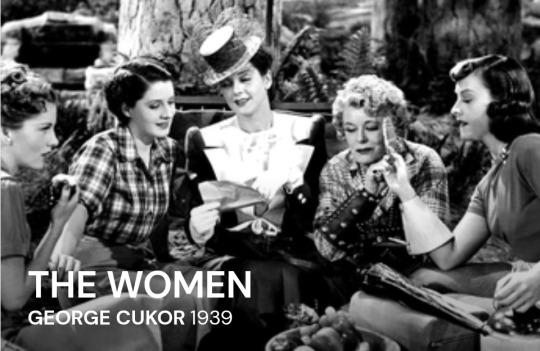
For anyone who is a fan of Sex and The City, how about a late 1930s version? Fast pace dialogue, outfits to die for and a cast made almost entirely of women.
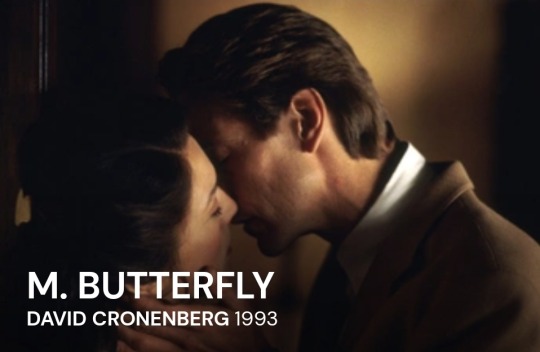
The second Cronenberg on the 2023 list. I watched M. Butterfly after seeing Madame Butterfly at the opera. The film is slightly different and it deals with some of my favorite themes in fiction and media lately: gender identities, criticism of colonialism, orientalist fantasies that obscure realities and so much more.
#m thoughts#top 10 films in 2023#crash david cronenberg#m butterfly#body double#hardcore 1978#fedora billy wilder#mommy dearest#women 1939#in bed with Madonna#crimes of passion#vive l'amour
20 notes
·
View notes
Text
Edible Cities are growing in the US and Europe
The city of Andernach, Germany, planted 101 varieties of tomatoes in the town center and told everyone to pluck and take whatever they wanted.
It was such a hit, the following year the city did the same with beans. The next year, it was onions. After that, the city planted fruit trees, lettuce, zucchini, berries and herbs. All were free to anyone who lived or happened to be in the town of 30,000 people.
The town, which sits in the Rhine River Valley, has an unofficial motto: “Picking is encouraged — help yourself.”
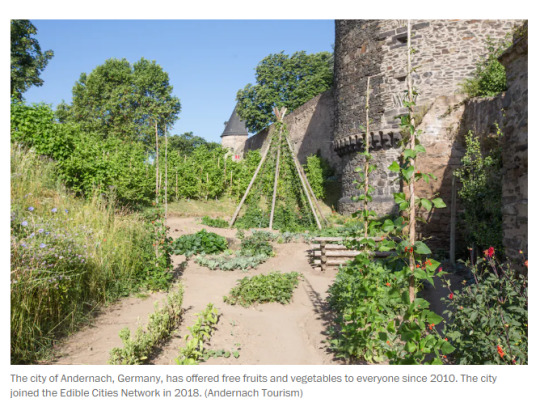
It’s one of a growing number of places across the globe known as edible cities. In the United States, there are public lands from Seattle to North Carolina where people are welcome to pick and take from fruiting trees and bushes.
Organizers interviewed for this article said there has never been a problem with people taking more than they need, whether they grab a single pear or a bag full of potatoes and artichokes.
Every year, there is more than enough produce to go around.

Detroit has an urban farming movement, Philadelphia has food forests, and there are edible community projects in Atlanta and Los Angeles. All rely on volunteers to do the weeding, pruning and planting.
Smaller cities such as Bloomington, Ind., and Hyattsville, Md., also have fruit trees and vegetable gardens that can be accessed by anyone.

111 notes
·
View notes
Text
do you guys want to hear about some Black-owned seed shops?
Yes? Okay!
Aina Company (Hawai’i) [1]
Backyard Garden Seeds (Olive Branch, MS) [1] [2]
Big Fig N Vegetables on Etsy (Richmond, VA) [1] [3]
Black Thumb Seed Co (southern FL) [2]
Chef Ietef (Oakland, CA) [1] [3]
Coco and Seed on Etsy (Chandler, AZ) [1] [3]
Concrete Garden Seeds (Port Orange, FL) [2]
God’s Garden Girl (Newnan, GA) [2] [3]
Grow the Block Girl (website unavailable?) [1] [2] [3]
The Farmer Ken Shop on Etsy (Los Angeles, CA) [1]
The Hood Garden (zone 6b lol) [1] [2] [3]
I Grow Shit! (???) [1] [2]
Ivy Leaf Farms (Houston, TX) [1] [2] [3]
Let’s Gro the Garden Life [2]
Melanated Organics (south GA) [1] [3] [4]
Microbes by Marco (central VA) [1] [2]
Naturally Dope also on Etsy (Columbia, MD) [3]
Okra Lady Seed Shop on Etsy (San Antonio, TX) [1] [3]
Overflow Farms (Riverside, CA) [2] [3]
Polycultured [3]
Renaissance Farms (southern IN) [2] [3]
Seed Mail Seed Co. (West Palm Beach, FL) [1] [2] [3]
Sistah Seeds (Philadelphia, PA) [3] [4]
Soil Vibes on Instagram (New York, NY) [2] [3]
Soul Gardener 74 on Etsy (on hiatus) [1] [2] [3]
Tennessee Tropicals (Springfield, TN) [3]
True Love Seeds (Philadelphia, PA! AND ON TUMBLR!!!) [3]
Urban Farms Garden Shop (Zionsville, IN) [2] [3]
Urban Garden Project (Houston, TX) [3]
bonus Asian veggie seed vendors:
Kitazawa Seed Co. [1] [4]
SeedLoversVA21 on Etsy (Annadale, VA) [4]
References:
[1] What MJ Loves
[2] Princess Cole (aka the proprietor of Backyard Garden Seeds!)
[3] Black Girls Gardening in Containers
[4] me (peep some of my favorite Etsy shops)
@crip-walking-on-sunshine
@ladyknighttime
@spiralsketchbook
@tchallasbabymama <3
69 notes
·
View notes
Text
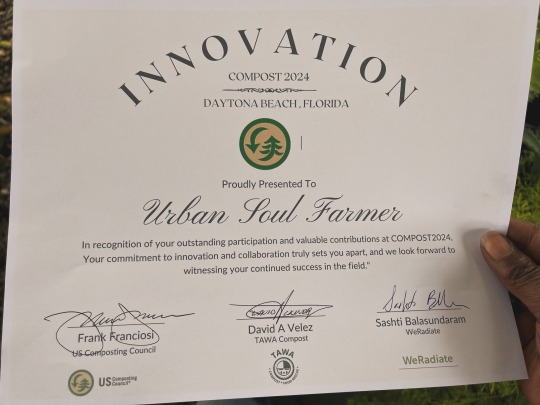
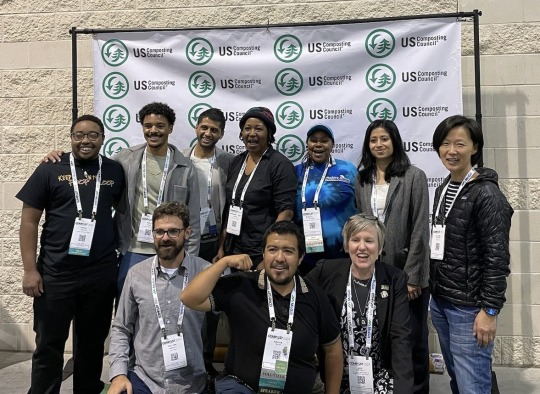




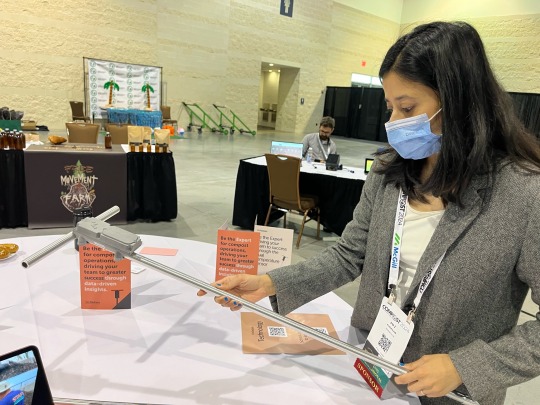

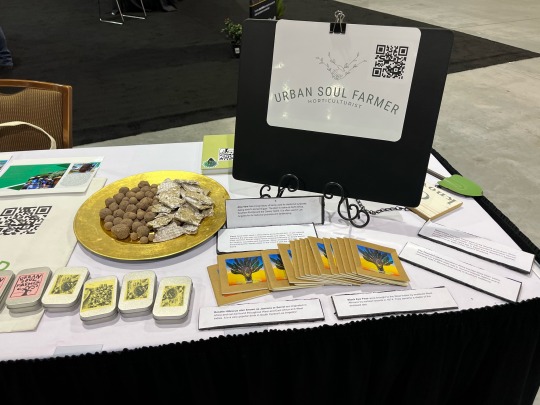
I had a blast at the International compost council conference in Daytona Beach, Florida meeting people in this industry from all over the world and country. Thousands of attendees and I was one of 5 innovative micro businesses invited to represent Urban Soul Farmer.
So much to process including how I will move forward in making USF even more accessible.
There is no Urban Soul Farmer without community. Forever grateful 🙏🏾🙌🏾💚😁
40 notes
·
View notes
Text
Just weeks after a third of the US population was hit with air-quality alerts thanks to smoke from climate-change-fueled fires in Canada, 100 million Americans are now under heat alerts. A cap of extra-hot air, known as a heat dome, has settled over the West and South, pushing temperatures relentlessly higher.
The map below shows excessive heat warnings in purple and heat advisories in orange, and the forecast is that things will get worse through the weekend. Highs will stay above 110 degrees Fahrenheit in Phoenix; California’s Death Valley is flirting with 130 degrees; and Texas’s grid is struggling to keep the AC on.
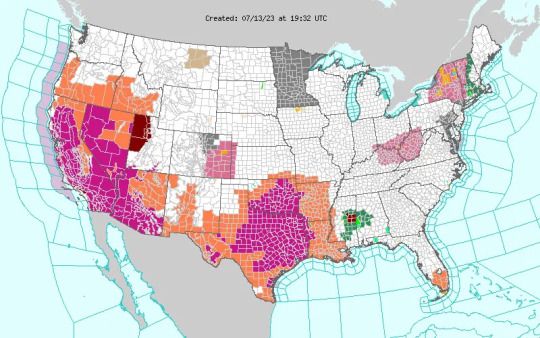
This follows the hottest June on record globally. “With an evolving El Niño event, that is certain to further increase global temperatures,” says Howard Diamond, climate science program manager at the National Oceanic and Atmospheric Administration’s Air Resources Laboratory. (El Niño is a band of warm water that develops in the Pacific Ocean and influences weather around the world.) “Canada has also experienced multiple bouts of prolonged heat this summer, contributing to the worst wildfire season the country has ever seen,” Diamond adds.
A heat dome is essentially stagnation. It forms as a strong high-pressure system. As that air descends to the ground, it compresses and significantly warms up: A few thousand feet up, air might be 80 degrees, but it can reach 100 degrees once it hits the land.
This descending cap of hot air self-perpetuates for days or even weeks. It discourages the formation of clouds, allowing the sun’s energy to hit the landscape full force, further raising ground temperatures. At the beginning of a heat dome, moisture in the dirt and plants evaporates away, somewhat cooling the landscape—it’s sweating, basically. But as the heat continues for days on end, that moisture runs out and temperatures climb higher.
In other words, the heat dome feeds on itself. “There is no cloud cover, there is a lot of solar radiation coming in, there is no precipitation,” says Claudia Tebaldi, a climate scientist at the Pacific Northwest National Laboratory. “You also trigger this feedback—you dry the soil, and there is no way for things to cool down by evaporation.”
That self-perpetuation makes heat domes extremely dangerous. It’s bad enough when temperatures rise above 110 for a single day, especially for people with conditions like asthma, because the heat leads to the formation of ozone, which irritates the airways. But if temperatures soar for days—and especially if temperatures stay high overnight—the body has no time to recover. The stress keeps piling up.
This is all the more precarious in big cities like Phoenix, Houston, and Los Angeles—all of which are baking right now—due to the urban heat island effect. The concrete and brick of the built environment absorbs the sun’s energy, launching temperatures way higher than in surrounding rural areas, which can rely on plants to cool things off. Buildings and other infrastructure then slowly release that heat through the evening, meaning nighttime temperatures stay high. That affects not only people’s physical health but also their mental health, if they’re not able to sleep night after blazing night. Low-income neighborhoods suffer the worst, as they’re consistently and quantifiably hotter than richer ones, since they have fewer green spaces like parks and gardens.
Climate change, of course, is making extreme heat more extreme. “The trend of temperatures increasing everywhere over time is unequivocal,” says Diamond. “An average summer today, for example, might have been considered a hot summer several decades ago. Likewise, a hot summer in the future may very well be considered an average one a few decades from now.”
Scientists are still debating whether climate change will make heat domes more common, says Tebaldi, since their formation depends on complex atmospheric dynamics. The severity of heat domes, though, is a different question. Because the world is generally getting hotter, heat domes start off with temperatures that are higher than before, which could boost their ability to feed back on themselves. This is similar to climate change’s effect on hurricanes: It might not make them more common, but because the storms feed on warmth in the Atlantic, higher temperatures could make them more intense.
Climate change is also exacerbating droughts, meaning there’s already less moisture in the landscape that could evaporate to offset some of the heating, at least in the early stages of a heat dome. “Heat domes are not new,” says Diamond. “But their extent, duration, and amount of extreme heat could very well be attributed to the climate change that we are seeing across the globe.”
13 notes
·
View notes
Text
If you are in Southern California, there is native buckwheat growing wild everywhere. See photo below. They make attractive informal hedges and grow nicely between roses. You can also purchase plants for your yard at any local native plant sale.
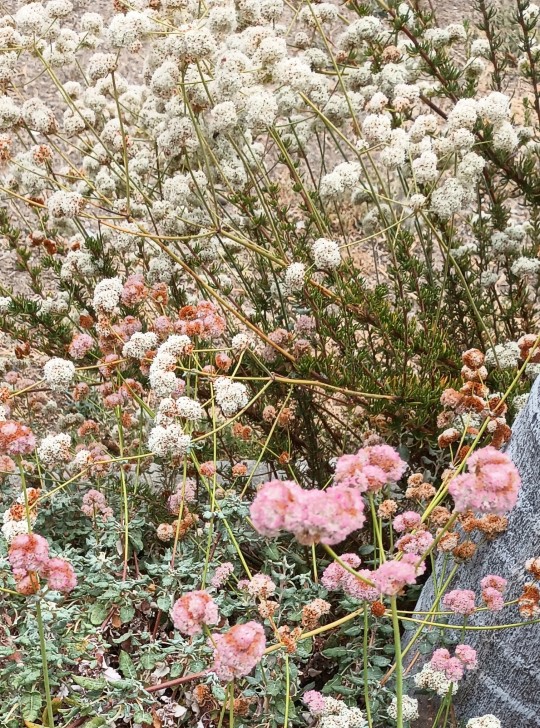
Now (fall/winter) is the time to harvest the seed heads to make a gluten free flour substitute. (You can also eat the young shots in spring, which have a lemony flavor). One plant can easily yield one or more paper grocery bags of seed heads. See photo below. (They are a little underripe, the dark brown ones are fully ripe and ok to collect as well. White seed heads are too immature).
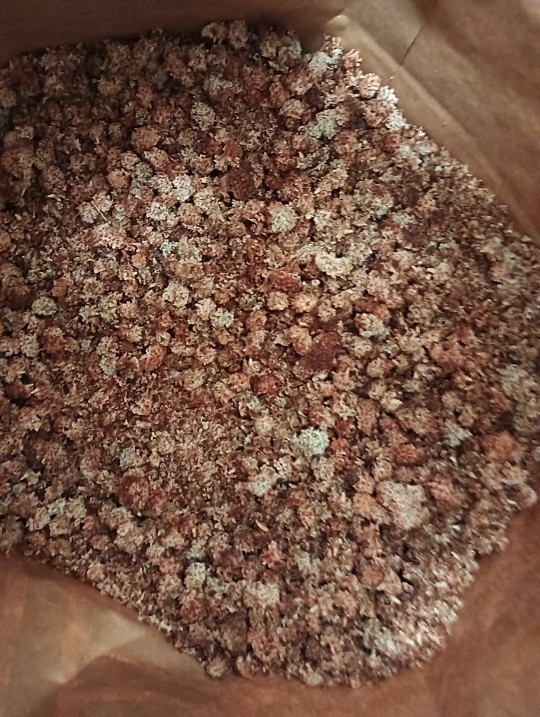
Once you have acquired your seed heads (we grow several plants), it is time to get them ready to eat. They need to be soaked overnight to get rid of the bitter compounds. Put them in twice as much volume of water as you have seed heads and soak overnight (8-12 hours).

Once they are done soaking, scoop them out into a fine strainer and rinse until the water runs clear. Be careful with soaking water as it may stain surfaces (or experiment with using it as a dye). Once you are done rinsing, it will look like below.
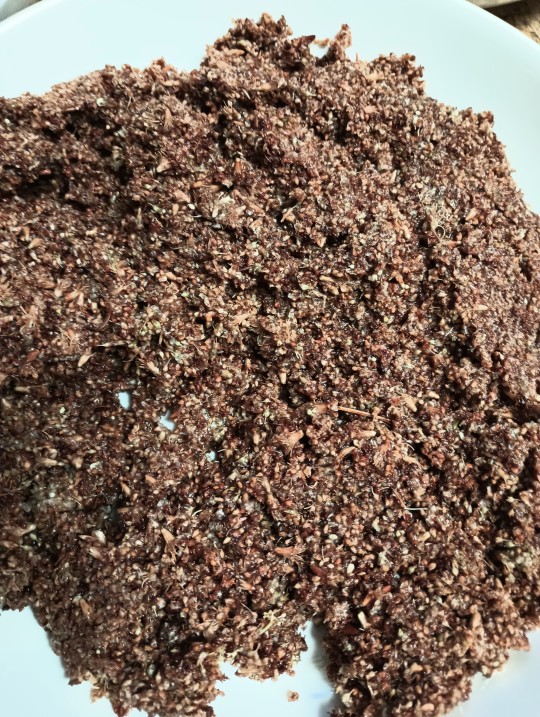
At this point, you can cook everything up wet like a porridge. If you want to keep it longer, you will need to dry it. You can spread in thin layers to air dry or put it in a dehydrator on low (which is what I do). Once it is dry, you can store it in glass jars to use as a gluten free flour substitute. It has a distinct flavor, so have fun experimenting. It makes delicious pancakes, especially when mixed with an equal part of acorn flour (see previous post). Photo below shows after dehydration.

You can grind the flour in a blender to make a finer texture, or toast it before use to alter the final flavor.
#California buckwheat#urban garden los angeles#urban foraging#free food#california native plants#gluten free#flour substitute#wild grain
15 notes
·
View notes
Text
For most people, discovering a frog living in your fence post would make you feel either kind of creeped out or kind of charmed. For one guy in Australia, it was a challenge: He decided to make it the sweetest pad possible. In a now-viral two-minute TikTok video, he designs and 3-D-prints his frog an elaborate home. He keeps adding features until the lucky amphibian has an attached pool, a downstairs mating pond with a tadpole ramp, and a predator-proof safe room.
This frog house was gleefully over the top, practically engineered to go viral with its renovations for “increased ribbit amplification” and a brushtail possum who occasionally likes to drink water from the pool. But frog houses as an idea are worth taking seriously. Animals don’t need much to get cozy in our backyards and balconies, as the world has already learned with birds. One ecologist found that bird feeding goes back at least 3,500 years; in the 18th century, the facades of Ottoman palaces and mosques were fitted with structures to house birds, who were seen as both holy and lucky. Birdhouses and bird feeders are so thoroughly part of human culture that purple martins in eastern North America nest almost exclusively in houses made by humans.
But why do birds get all the love? Building a little house for a frog to shelter in, or a pond where eggs can hatch and tadpoles can grow, is a great idea if you’ve got a place to put it. Even a tiny pondlet in a container on a patio can raise a whole amphibian generation. You can provide meaningful help to animals that need it, and participate in species conservation at home with very few downsides. Honestly, creating a backyard pond is probably better than putting up a birdhouse. Will someone please think of the urban amphibian?
Birds are beautiful, and they sing—it is no wonder we have long welcomed them into human spaces. At some level, it doesn’t even feel like sharing space, because birds live up high, in trees and on rooftops and telephone wires. They get the sky, and we get the land. Seems fair. But frogs? Inviting them into the garden can make you feel uneasy. Whereas birds are “so obvious and so charismatic,” Erin Sauer, an ecologist at the University of Arkansas who has studied both urban birds and urban amphibians, told me, frogs are “cryptic” and “camouflaged”—“they don't want you to find them.” Many frogs in temperate zones, including much of the United States, are brown and green, and more active at night. They are a subtle pleasure, compared with a crimson cardinal or an iridescent hummingbird.
It might not be obvious that some amphibians are probably living not too far from you, in part because they stay hidden. Frogs, newts, and salamanders exist in most cities. In New York, you can hear gray tree frogs call in Brooklyn Heights. In Los Angeles, the canyons of Griffith Park are filled with bumpy western toads. According to the biodiversity tracker iNaturalist, 28 species of amphibians have been spotted in Columbus, Ohio, including the colorful eastern red-backed salamander.
But amphibian populations are declining. Forty-one percent of amphibians are threatened with extinction, in part because of an ongoing fungal pandemic that as of four years ago had driven an estimated 90 species extinct. Frogs also have habitat needs that are “so specific,” Sauer said: They must have both water and land to complete their life cycle.
Still, if there are frogs near your home and some relatively protected route for them to travel, and you build a pond with vegetation around it, they will likely move in. An analysis of dozens of projects that created ponds for amphibians found that in every study, frogs showed up at some or all of the ponds. And many of the studies found that the number of species was similar or higher in created ponds than in natural ponds. Not all of those ponds were in cities, but another study looked at ponds in Portland, Oregon, and found similar results. The biggest predictor of how well a pond attracted frogs wasn’t whether it was real or fake, but the amount of plants growing in and around it.
Frog ponds aren’t very common residential features (yet), but it isn’t like no one thinks of amphibian-kind when designing their outdoor space. The U.S. Department of Agriculture has some advice for creating effective backyard conservation ponds for native wildlife. There are any number of guides online to building toad abodes, frog hotels, and general-purpose backyard frog ponds. Some gardeners install toad houses, hoping that a toad will move in and pay rent by eating common garden pests. You can even buy handmade toad houses on Etsy. And naturally, TikTok Frog House Guy is now selling frog houses as well.
It can be simple, and cheap, to invite amphibians over to your place. Tree frogs love to hang out inside vertical tubes, so simply pounding a few PVC pipes into the ground can create a little frog hotel. Building a cozy house for toads can be as easy as half-burying a broken pot. Making a frog pond is as straightforward as digging a hole; setting a commercial pond liner, an old bathtub, or even a plastic storage tote in the hole; and filling it with rocks and water. “You don’t need to 3-D-print some elaborate frog mansion,” Sauer told me.
I had called Sauer to set my mind at ease on one point: Would creating an artificial house or pond also create a transmission point for disease? She told me it wasn’t worth worrying about. Yes, multiple frogs might move into a pond or house, and they might touch if they mate, but frogs already gather in groups naturally, whereas birds at bird feeders can congregate in unusually high numbers. Feeders can pose a disease risk to birds, Sauer said: “You have a single place with one porthole, and they stick their faces in there and chew on things. And then their friends come over and do the same thing.” A frog pond can even bring in birds, who will use it to bathe and drink—with less chance of disease transmission.
There are very few downsides to catering to your local frogs, the biggest of which is that your backyard might have more mosquitoes—mosquitoes, like frogs, breed in water. To avoid that, you either need animals that will eat all of the mosquitoes (such as dragonflies or some tadpoles) or you need to keep the water moving. A solar-powered aerator costs about $30.
It is very possible that the frogs that show up to your patio water feature won’t be critically endangered species, but that’s okay. “We want to keep common species common so they don’t decline,” Sauer said. It all helps. Providing habitat for amphibians is important, but researchers are also working on frog houses that will actually help save frogs from the fungal pathogen. These houses would be like little greenhouses: hot enough to kill the fungus but not too hot for the frog’s comfort.
Not everyone can or wants to build a frog house. But they might be interested in putting a pot full of wildflowers for pollinators on their balcony. Saving species in the 21st century isn’t just about protecting big, undeveloped parks—although we need those too. It is also about figuring out how to coexist with the many species that can thrive in the urban, suburban, exurban, and agricultural landscapes we’ve made. That we’ve shared space with birds for thousands of years proves we can do it.
There’s evidence that this is already happening, and birdhouses and frog houses are just the beginning. People are adding bee hotels and bat houses, and planting milkweed for endangered monarch butterflies to lay their eggs on. It can be dizzying to think about all the species that need help right now, but engaging in everyday conservation can also just be fun, helping to turn neighborhoods into corridors of habitat for creatures such as frogs. Our cities can be wetlands too, at least in spots. Our kids can watch tadpoles on summer days. And in the spring, we can listen to the frogs sing at dusk.
— You Should Build a Frog Pond
#emma marris#you should build a frog pond#environmentalism#ecology#wildlife conservation#history#animals#frogs#salamanders#newts#toads#gray treefrog#western toad#red-backed salamander#mosquitoes#dragonflies#ottoman empire#erin l. sauer
8 notes
·
View notes
Note
I like your vision for cities but how is something like that achieved practically speaking?
oh boy. here we go...
zoning reform: more mixed-use zoning. japan's zoning model is one i particularly like. but i also think there are some european cities to look to. would like for there to be some national agency that sets some standards but i know that's a longshot.
land value tax: will incentivize denser development and more efficient use of land. this, aside from zoning reform, will probably make the biggest difference.
carbon tax: decrease pollution and discourage cars.
congestion pricing: decreases traffic
build more pedestrian-friendly streets: wider sidewalks (and thus smaller streets, probably with lower speed limits but of course it will be situational), well-lit, more greenery, designate certain streets as pedestrian-only, etc.
encourage and invest in public transportation: buses (especially brt), trains, subways, trolleys, monorails, funiculars, etc. this includes intra-city transit but also transit to outlying suburbs (and ideally those suburbs would follow similar policies as discussed here -- like the streetcar suburbs of old). i also don't think it should be free, at least not at first. though maybe subsidized. i think it should cost /something/ though (i also like the idea of making lots of ways to get discounts so it gives the appearance of being high-value while also being accessible). and importantly we need to make sure it is clean and safe. which brings me to my next couple points.
law and order: police. we need more and better police. for a lot of people this is a hard pill to swallow but it's the truth. we need to be cracking down on crime and getting homeless off the street. this is probably the third most important thing after the land-value tax.
cleanliness: i think there should be some kind of public jobs program for cities where they hire people to do some basic low-skill janitorial work throughout the city. like a whole ass street cleaning corps.
beautification: incentivize businesses to build more beautiful buildings in pedestrian-heavy areas and build more public monuments and parks and plants more trees and flowers.
encourage urban gardens: not because this is going to solve any food shortages or anything but mostly as a means of fostering community.
build more diverse housing: not just high-rise apartments and single family homes (though i think they both definitely have a place). there's a range of other options; low-rise and mid-rise apartments, townhouses, multiplexes (duplex, triplex, fourplex, etc), courtyard apartments, bungalow courts, 5-over-1s, get single family homes to build accessory dwelling units, live-work homes, etc. also encourage more housing co-ops.
i do also want to mention suburbs again. like i said, i think a lot of the above principles should be applied to suburbs too. i think they should be more dense. not necessarily "high-density" like a downtown urban area but medium-density for sure. if big cities have an "urban core" i think suburbs should also act as "suburban cores" with walkable city centers where there are lots of jobs and entertainment and so on. we used to have streetcar suburbs and we should strive to revive this.
suburbs get a lot of flak and a lot of the criticisms are valid but i don't think suburbs are inherently bad. the cookie-cutter urban sprawl in the sunbelt is pretty bad. but i live in a suburban town just outside of los angeles and it's really lovely. it's full of character and community and it's walkable and has a lively and charming downtown area. suburbs can be good. we just need more suburbs that have a medium-density walkable "small town" vibes than the soulless cookie cutter stuff you see people rail against all the time.
3 notes
·
View notes